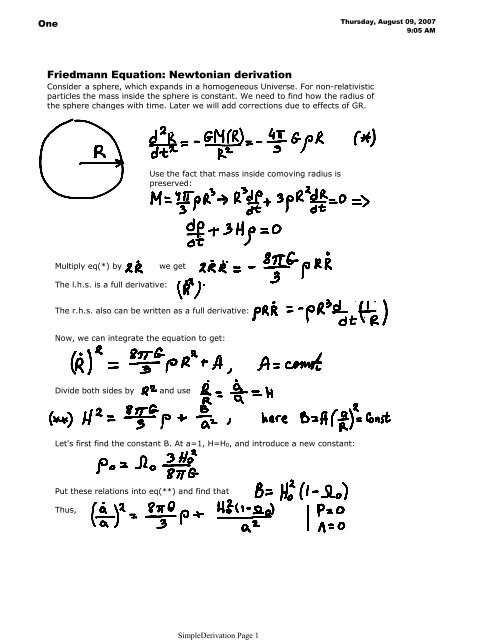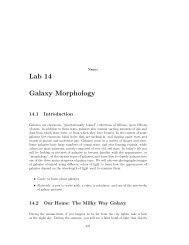Friedmann Equation: Newtonian derivation - Astronomy
Friedmann Equation: Newtonian derivation - Astronomy
Friedmann Equation: Newtonian derivation - Astronomy
You also want an ePaper? Increase the reach of your titles
YUMPU automatically turns print PDFs into web optimized ePapers that Google loves.
One<br />
<strong>Friedmann</strong> <strong>Equation</strong>: <strong>Newtonian</strong> <strong>derivation</strong><br />
Consider a sphere, which expands in a homogeneous Universe. For non-relativistic<br />
particles the mass inside the sphere is constant. We need to find how the radius of<br />
the sphere changes with time. Later we will add corrections due to effects of GR.<br />
Multiply eq(*) by we get<br />
The l.h.s. is a full derivative:<br />
Use the fact that mass inside comoving radius is<br />
preserved:<br />
The r.h.s. also can be written as a full derivative:<br />
Now, we can integrate the equation to get:<br />
Divide both sides by and use<br />
Let's first find the constant B. At a=1, H=H0, and introduce a new constant:<br />
Put these relations into eq(**) and find that<br />
Thus,<br />
SimpleDerivation Page 1<br />
Thursday, August 09, 2007<br />
9:05 AM
two<br />
Because for non-relativistic particles mass in a comoving volume is preserved, we<br />
can re-write the Fieadmann equation in a different form:<br />
Critical density:<br />
Special case:<br />
We can find how the contribution of matter to the total density changes with time:<br />
If , then<br />
If , then<br />
SimpleDerivation Page 2<br />
Sunday, August 12, 2007<br />
5:31 PM
three<br />
In this case<br />
Solution of this equation is:<br />
Age of the Universe<br />
SimpleDerivation Page 3<br />
Sunday, August 12, 2007<br />
7:47 PM




